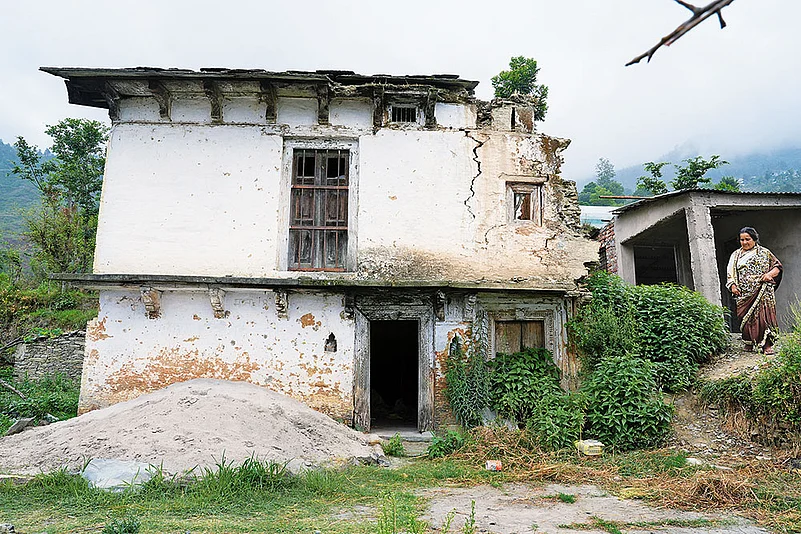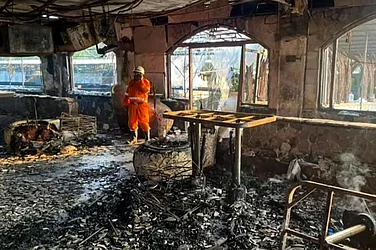In 1969-70, an obscure village—Garadiya-Kund, some 8 km from Pauri in the Garhwal hills of Uttar Pradesh (UP, and now Uttarakhand)—scored a unique distinction. Giridhari Lal Jhaldiyal of this village won the state government’s prize for producing best-quality cucumbers and demonstrating rare farming skills to grow high-quality fruits like apples, peaches and apricots.
Late Jhaldiyal’s son Ganesh Prasad Jhaldiyal, who is a retired UP-cadre civil services officer and currently in his 90s, has preserved his father’s certificates and trophies for archival value. “It is not a mean achievement of this man, a distinguished farmer of his times. My father had served in the UP electricity department. When he retired, he chose to go back to his village and started growing high-end crops and fruits. The local climatic conditions, highly fertile soil and abundant natural water needed only passion to turn the tables,” recalls Jhaldiyal. Thereafter, Pauri has not only remained a hub for self-sustained farming, but also a water reservoir comprising natural springs.
Three years ago—almost half-a-century after Jhaldiyal’s tryst with farming—41-year-old Deepak Nautiyal of Kyark, a village affected by migration—reached Pauri with a dream to do something similar. He had quit his job with a multinational company to venture into kiwi farming in Pauri, his hometown. His vision was not just to grow fruits in the barren land, but also to inspire youth to reverse the burgeoning migration problem in Uttarakhand’s hills.

“I nurtured the farm with full care and diligence, but the experiment seems to be failing. You can see now what has happened on the ground. The fruit has withered due to lack of timely rains,” he says, quoting it as a real-time example of the impact of climate change on the farm sector across the state and mountain communities.
It is evident that climate change has led to erratic weather, altered rainfall patterns with frequent droughts and dried up natural sources of water. Snowfall in Pauri is a rare event now. With migration at its peak, there is nobody to revive or maintain the traditional water sources—the lifeline of the mountains.
The drying up of natural water sources has cast its shadow on some of the ancient social practices that were part of Garhwali culture. One such practice—Dhara puja, a ritual to worship natural water sources by a newly-wedded daughter-in-law—has practically vanished. Popular Garhwali singer, Narendra Singh Negi, says, “When natural sources of water have dried up, there is little relevance left to this symbolism.”
The increased risk of climate change-induced glacier melting can lead to the formation of unstable glacial lakes that can burst and cause devastating floods downstream.
Ironically, Uttarakhand, also known as Dev bhumi, is a state home to over 40 rivers, including sacred rivers such as Ganga, Alaknanda, Bhagirathi, Mandakini and Saryu. But now even hand pumps and water supply schemes are failing to meet the water needs of the rural population. The irrigation facility in Garhwal is already below 10 per cent.
The traditional cropping patterns across the state have changed drastically. The cultivation of subsistence cereals, including millets, oilseeds, and pulses that have been a source of livelihood in the Garhwal region, is almost non-existent. Experts say that this is due to climate change triggering extreme geo-hydrological disasters and declining soil fertility. The Garhwal Himalayas were known for its rich agro-biodiversity and had more than 87-90 varieties of crops.
Paddy has disappeared from the farming landscape. Potatoes and several varieties of millets grown in the Garhwal region have vanished. Indigenous crops have become extinct. It’s only people like Vijay Jhardari, a small farmer from Tehri, who are trying to save ancient seed varieties of crops—wheat, barley, paddy, kidney beans, cowpea, buckwheat and Navrangi Dal. Jhardari, 73, spearheaded the seeds movement (Beej Bachao Andolan) in the mid-1980s.
“The land has turned barren. After the government built a road to our village, people have migrated to other places. There is no one left to cultivate the barren fields. Not a blade of grass can be seen anywhere. To get fodder for cattle is a challenge,” says 61-year-old Harish Chander in Kagdi village, some 21 km from Srinagar.
Nearly 2,000 villages in Uttarakhand—1,670 as per the findings of the Uttarakhand Migration Commission—have been affected by mass migration; Pauri is the worst affected region. As per the 2011 Census, 734 villages have become completely de-populated and are called Bhootiya gaon (ghost villages). In Chandola Rain village, nine km from Pauri, over a century old houses are in shambles and have been abandoned. One can see the crumbling walls of majestic, old style three-storeyed houses where families must have lived in prosperity. The houses had been built with mud and wood (without cement) using cut-stones. The slanting slate roofs were constructed to suit local conditions and support village architecture.
“We have reached the threshold. There is no other alternative except to maintain a balance between the environment and development,” advocates Srikant Chandola, a retired principal chief conservator of forests.
After thousands of trees were felled to construct the ambitious Char Dham National Highway and the Delhi–Dehradun Expressway, not a single tree has been re-planted. Mindless development, slicing of mountains, blasting, deforestation, and forest fires have made this area a dangerous territory. Tunnel tragedies like in Silkyara, Uttarkashi, in 2023 are an eye-opener, but no lessons have been learnt.
Historically, Uttarakhand has seen major environmental movements like the Chipko movement against deforestation. Equally impactful was the Nadi Bachao Andolan to save the state’s rivers from the construction of dams. Yet, hill communities continue to bear the brunt of environmental degradation and the impact of climate change. Scientists warn that the state may witness more flash floods, avalanches, landslides, Glacier Lake Outburst Floods (GLOF) and climate migration as a result of the changes taking place in the Himalayas.

Kalachand Sain, director, Wadia Institute of Himalayan Geology (WIHG), Dehradun, says, “Apart from climate change-induced risk factors, the Himalayas are witnessing rapid geo-seismic activities. The high-altitude areas are vulnerable to disasters. The risk of such disasters is increasing each day because of anthropogenic activities in the fragile geology.”
A young scientist at WIHG, Manish Mehta, has conducted in-depth studies on glaciers in the high Himalayas, including in Ladakh and Uttarakhand. The impact of global warming and rising temperatures is evident in the changes happening there, he says. Change in snowfall pattern, from December-January to February-March, as per Mehta, is also impacting the weather cycle in the mountains.
This year’s unprecedented seasonal forest fires in Uttarakhand have severely damaged the state’s rich biodiversity.
The increased risk of climate change-induced glacier melting can lead to the formation of unstable glacial lakes that can burst and cause devastating floods downstream. “We have asked the state government to undertake in-depth studies of five glacier lakes, which could cause serious risks of GLOF. The government has also been advised to conduct detailed geo-seismic studies of major sites of infrastructure projects before their implementation,” says Sain.
Climate change is severely affecting both population dynamics and displacement in Uttarakhand. The migration has direct implications on the state’s socio-economic growth and food security. Dehradun-based social activist, Anoop Nautiyal, shares concerns about 402 villages of Uttarakhand affected by climate migration. “The glaring case of Raini village in Uttarakhand’s Chamoli district is an-eye opener. This is the same village where the Chipko movement started in 1973. The village was hit by GLOF in February 2021, leaving over 200 dead. Subsequently, it was declared inhabitable. The families are still awaiting rehabilitation,” he points out.
This year’s unprecedented seasonal forest fires in Uttarakhand have severely damaged the state’s rich biodiversity. This impact is compounded by the loss of carbon stocks in the forests, further intensifying global warming. In Pauri, a vast tract of burnt forest stock tells the story of how the fires have devastated the forests and soil conditions. Jaisingh Rawat, a veteran Dehradun-based journalist, quotes a study published in Atmospheric Environment in February 2021 to highlight the risks of forest fires. “There is a close relationship between forest fires and cloudburst incidents. This study was jointly conducted by the Hemvati Nandan Bahuguna Garhwal University and the Indian Institute of Technology, Kanpur. The scientists measured the activation of cloud condensation nuclei (CCN) and found that forest fires can trigger more cloudbursts in the region,” he says. These fires also release large amounts of carbon dioxide into the atmosphere, contributing to regional and global climate change, claims Rawat.
Landslides, lightning and cloudbursts in the Himalayan region are not uncommon phenomena, but their intensity has been constantly increasing over the years. P S Negi, an expert on Himalayan geology and disasters who studied the June 2013 Kedarnath floods—the biggest tragedy in recent times that left 6,054 people dead—terms it as an incident of “climate change aberration”. The floods occurred due to a cloudburst that caused unusual rainfall in Uttarakhand—almost 400 per cent higher than the normal rainfall.
Anoop Nautiyal points to the callous attitude and the insensitivity of the government towards the growing concerns about climate change. Unfortunately, no one is ready to talk about mitigation measures and preventing disasters. The Rishikesh-Karnaprayag Railway Line under-construction could destabilise the mountains and put the fragile ecology under stress, say experts. Amidst the rapid changes, there is yet a ray of hope in the mountain spirit, resilient peaks and the holy waters of the Ganga and the Bhagirathi.
MORE FROM THIS ISSUE
Ashwani Sharma in Pauri, Uttarakhand
(This appeared in the print as 'An Elegy For The Hills')

































